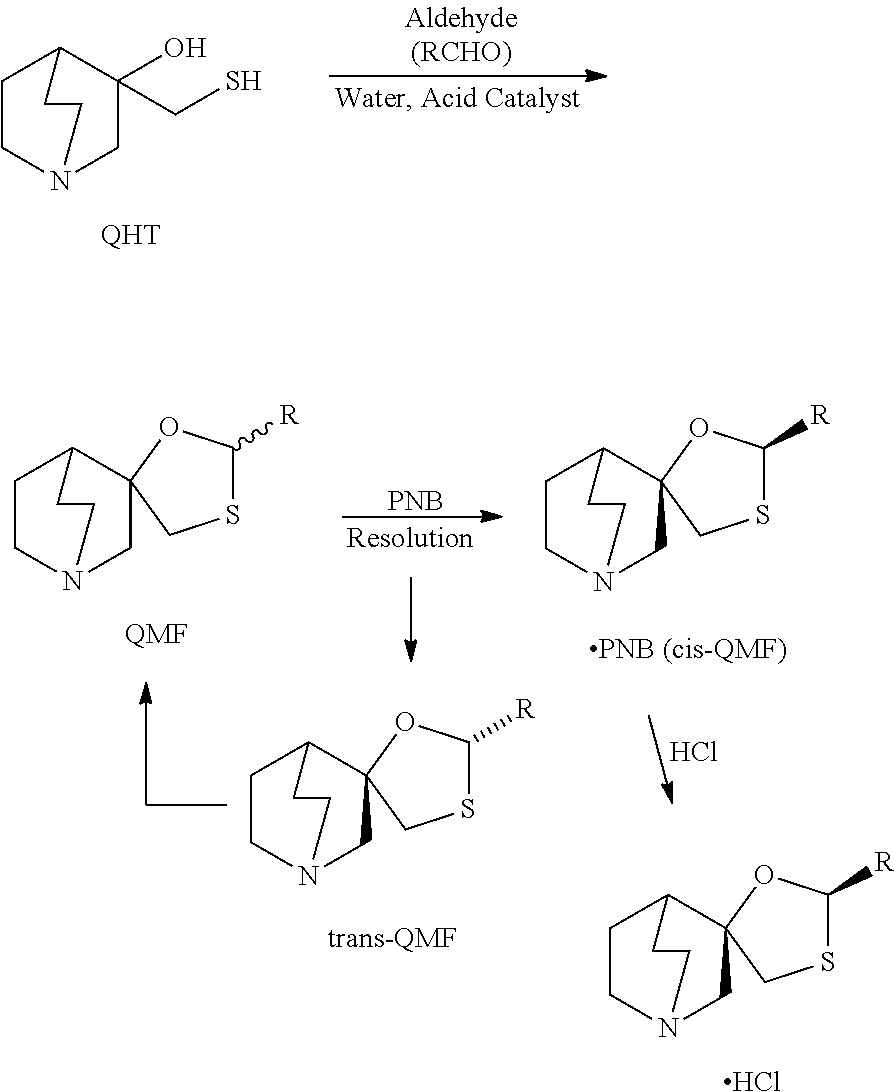Process for production of quinuclidine compounds
a quinuclidine and compound technology, applied in the direction of organic racemisation, drug compositions, immunological disorders, etc., can solve the problems of high environmental burden, unfavorable industrial applications of metal halogen reagents, and large energy required for organic solvent recovery, etc., to achieve high yield
- Summary
- Abstract
- Description
- Claims
- Application Information
AI Technical Summary
Benefits of technology
Problems solved by technology
Method used
Image
Examples
example 1
[0040](1) 10.0 g of QHT and 20 mL of water were added to a 100-mL three-necked flask equipped with a stirrer and a thermometer, and the mixture was cooled to 10 to 15° C. 7.63 g of paraldehyde and 48.6 g of a 48% hydrobromic acid aqueous solution were added dropwise, and the mixture was heated to 40° C. and stirred at the same temperature for 20 hours. The reaction solution was cooled to 25° C., and 42 mL of toluene were added to separate the solution. 42 mL of toluene were added again to the aqueous layer to separate the layer, and the separated aqueous layer was cooled to 10 to 15° C. 33 mL of a 28% sodium hydroxide aqueous solution were added to make the layer strongly alkaline, followed by extraction and separation with 84 mL of toluene. 16.8 mL of water were added to the toluene layer to separate the solution, and 0.84 g of activated carbon was added to the separated toluene layer. The mixture was stirred, and the activated carbon was collected by filtration. The collected acti...
example 2
[0043](1) 500 g of QHT and 500 mL of water were added to a 10-L four-necked flask equipped with a stirrer and a thermometer, and the mixture was cooled to 10 to 15° C. 381.3 g of paraldehyde and 1,945.6 g of a 48% hydrobromic acid aqueous solution were added dropwise, and the mixture was heated to 20 to 30° C. and stirred at the same temperature for 5 hours. The reaction solution was cooled to 10 to 15° C., and 1, 350 mL of a 28% sodium hydroxide aqueous solution were added to make the solution strongly alkaline, followed by extraction and separation with 3,750 mL of toluene. 1,500 mL of water were added to the toluene layer to separate the solution, and 1,040 mL of a 10% sulfuric acid aqueous solution were added to the separated toluene layer. The mixture was stirred and separated.
[0044]100 mL of a 10% sulfuric acid aqueous solution were added again to the separated toluene layer, and the mixture was stirred and separated. All the sulfuric acid aqueous layers were combined, to ther...
example 3
[0047](1) 131 mL of a 28% sodium hydroxide aqueous solution were added to 2,099.2 g of the filtrate obtained in Example 2 (2) (cis isomer / trans isomer=22.3 / 77.7, content: 222.2 g in terms of QMF) to make the filtrate strongly alkaline, followed by extraction twice with 2,043 mL of toluene. 817 mL of water were added to the toluene layer to separate the solution, and 40.9 g of activated carbon were added to the separated toluene layer. The mixture was stirred, and the activated carbon was collected by filtration. The collected activated carbon was washed with 409 mL of toluene, and 186.3 g of p-nitrobenzoic acid were added to the filtrate, followed by stirring. The inside of the reaction system was turned into a nitrogen atmosphere, and 553.9 g of a boron trifluoride diethyl ether complex were added. The mixture was heated to 40° C. and stirred for 1.5 hours. The reaction solution was cooled to 10 to 15° C., and 817 mL of water and 1,021 mL of a 28% sodium hydroxide aqueous solution ...
PUM
| Property | Measurement | Unit |
|---|---|---|
| temperature | aaaaa | aaaaa |
| temperature | aaaaa | aaaaa |
| temperature | aaaaa | aaaaa |
Abstract
Description
Claims
Application Information
 Login to View More
Login to View More - R&D
- Intellectual Property
- Life Sciences
- Materials
- Tech Scout
- Unparalleled Data Quality
- Higher Quality Content
- 60% Fewer Hallucinations
Browse by: Latest US Patents, China's latest patents, Technical Efficacy Thesaurus, Application Domain, Technology Topic, Popular Technical Reports.
© 2025 PatSnap. All rights reserved.Legal|Privacy policy|Modern Slavery Act Transparency Statement|Sitemap|About US| Contact US: help@patsnap.com

